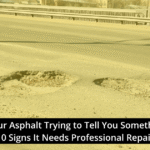It’s no surprise that Central Texas weather plays a major role in how long asphalt pavement lasts. At Contractors Asphalt, we understand how extreme heat, unpredictable rainfall, and seasonal temperature shifts can stress paved surfaces over time. These environmental factors directly affect how asphalt performs and how quickly it deteriorates. As a result, knowing how each season impacts your pavement helps ensure better long-term maintenance and smarter investment in your property. Here’s a closer look at the ways Texas weather influences asphalt durability, along with proven strategies for keeping it strong year-round.
Fluctuating Temperatures and Pavement Stress
Central Texas is known for its wide temperature swings, which introduce stress into paved surfaces. When temperatures shift suddenly between warm days and cool nights, the asphalt expands and contracts. Over time, this repeated motion weakens the pavement structure and encourages cracks to form. During winter, freeze-thaw cycles become more frequent, and any moisture that enters those small cracks will freeze and expand, widening them further. If ignored, this process leads to more visible damage and greater repair costs down the road.
Summer temperatures can be just as damaging. When the pavement heats up, the asphalt binder softens. This makes it more vulnerable to wear from traffic and heavy loads. Add in UV rays, and the surface can start to oxidize, becoming dry and brittle. This kind of damage often goes unnoticed until it spreads, which is why early repairs and seal coating are so important. When applied regularly, seal coating helps shield the asphalt from sun exposure and moisture, both of which speed up the breakdown process.
The Effects of Intense Summer Heat
Summers in Austin routinely bring temperatures above 100°F. Prolonged exposure to this level of heat puts asphalt under serious stress. The material softens, creating a risk of rutting or warping, especially in high-traffic areas like parking lots and commercial driveways. In addition, extreme heat accelerates oxidation, which causes the asphalt to lose flexibility. Without that flexibility, the surface becomes more prone to cracking under pressure.
Oxidation also causes the asphalt to fade from its original rich black to a dull gray, a sign that it’s losing its protective oils. These visible changes are often the first indication that maintenance is overdue. Proactive seal coating creates a barrier that slows oxidation and helps preserve the pavement’s appearance and integrity. When combined with regular inspections, this approach can significantly extend the life of your asphalt.
Autumn: A Smart Time for Repairs
Unlike summer, autumn offers cooler, more consistent temperatures that make it a good time for asphalt maintenance. Repairs and seal coating applied during this season cure more evenly, which improves performance and longevity. If the pavement took a beating during the summer, now’s the time to address cracks, faded markings, and surface wear before winter moisture sets in.
By catching these issues early, you reduce the chance of water seeping into the pavement during colder months. Once water gets inside and freezes, it expands and causes more cracking. Fall is also an excellent time for parking lot striping or re-striping, as paint adheres better in mild weather conditions.
Rain and Water Damage Risks
Rainfall is another major factor in asphalt deterioration. While asphalt is designed to handle moisture, too much exposure—especially to standing water—can undermine its base layers. When water enters small surface cracks and is allowed to sit, it erodes the material beneath the pavement. This leads to soft spots, sagging, and eventually potholes.
The risk increases in areas with poor drainage. Without a proper slope or runoff system in place, water can collect at the edges or in surface depressions. Over time, this constant exposure accelerates damage and increases repair costs. That’s why routine maintenance should always include an evaluation of drainage systems. Cleaning out storm drains, sealing cracks, and re-grading surfaces as needed helps keep water from becoming a bigger problem.
Freeze-Thaw Cycles During Winter
Winters in Central Texas may be short, but they often bring enough cold snaps to trigger multiple freeze-thaw cycles. These cycles are particularly damaging to pavement. When water inside the asphalt freezes, it expands, creating pressure from within. As temperatures rise again and the ice melts, the pavement contracts. Repeating this cycle causes small cracks to spread and deepen quickly.
Even in milder winters, this back-and-forth motion stresses the structure. If the asphalt already has surface damage or unsealed cracks, the rate of deterioration increases dramatically. To minimize this risk, crack sealing before winter and periodic inspections are essential. These preventive steps can keep minor problems from growing into large-scale repairs come spring.
Spring and Moisture Saturation
Spring is a time of renewal, but it also brings rainstorms and moisture levels that can reveal or worsen existing pavement damage. Any cracks or weak points created during winter become prime targets for water infiltration. The increased rainfall during this season often overwhelms surface drainage, especially if debris has blocked catch basins or runoff systems.
In many cases, the surface may look fine after a storm, but moisture is slowly working its way into the base material. Once that happens, the pavement loses its strength and begins to sag or form potholes. Early spring inspections and patching services are key to catching these issues in time. If seal coating or crack sealing was delayed in the fall, spring is the next best opportunity to protect the pavement before summer heat returns.
Signs of Weather-Related Deterioration
Knowing what to look for can help you catch weather damage early. The most common indicators include:
- Surface cracking, especially in patterns known as alligator cracks
- Potholes forming in high-traffic or poorly drained areas
- Faded or oxidized pavement that has lost its dark color
- Water pooling in certain spots after rainstorms
- Edges beginning to crumble or show signs of wear
When these issues show up, it’s time to call in a professional to assess the extent of the damage and recommend a plan for repair. Taking care of them quickly keeps costs lower and prevents further deterioration.
Proactive Maintenance for Long-Term Value
Maintaining asphalt in a place like Central Texas means planning ahead for the extremes. It’s not just about reacting to damage; it’s about preventing it before it becomes serious. At Contractors Asphalt, we recommend a proactive approach that includes scheduled seal coating, crack sealing, and annual inspections.
The benefits of this strategy are clear: it helps preserve the structure of the pavement, prevents moisture intrusion, and keeps your surface looking well-maintained. Seal coating every few years protects against sun and rain damage, while prompt crack repair stops water from getting in and causing bigger problems. Incorporating these steps into your regular maintenance plan improves performance and reduces long-term costs.
Why Timely Repairs Matter
Waiting to fix small cracks or potholes can lead to major expenses later. Once water or traffic makes a minor issue worse, repair options become more complex and costly. Timely repairs, on the other hand, can extend the lifespan of your pavement by several years.
Fixing cracks, addressing drainage problems, and reapplying seal coating not only preserve the structure but also enhance the curb appeal of your property. Whether you’re managing a commercial parking lot or a private drive, this level of care reflects well on your business or community and reduces the chances of accidents caused by uneven surfaces.
Choosing the Right Contractor in Austin
When it comes to asphalt maintenance, experience with the local climate makes a big difference. At Contractors Asphalt, we’ve served the Austin area for decades, and we understand the toll this environment can take on pavement. Our team uses climate-adapted materials and proven techniques that hold up to Central Texas conditions.
We provide a full range of services, including asphalt paving, seal coating, concrete work, equipment rentals, and ongoing maintenance. Every project starts with a detailed site assessment so that we can recommend the best solutions for your needs and budget. Whether you’re preparing for a new development or preserving an existing lot, we’re here to make sure your pavement is ready for whatever the weather brings.
Protect Your Asphalt Investment in Central Texas
In a climate like Central Texas, your pavement faces constant environmental pressure. From blazing heat to heavy rains and the occasional freeze, each season presents its own set of challenges. The key to long-lasting asphalt lies in understanding how these elements interact with pavement and taking action at the right time.
At Contractors Asphalt, we combine industry knowledge with local experience to offer tailored maintenance plans that protect your investment. Don’t wait until small issues turn into major problems. Contact our team for a site evaluation and discover how professional care can add years of life to your asphalt surface. Your pavement deserves attention—and we’re ready to help it stand strong through every season.









